Day 3 of a three day long weekend of tours, our last day. It was a nice sunny day today, not too hot, with some hazy cloud, great weather to be out birding. We headed down to the Brecks to try to see some of the local specialities.
Stone Curlew is a scarce breeding species for which the Brecks is well known – it is one of the best places in the country to see them. There are a few remnants of grass heath left here, their traditional habitat, but many now attempt to nest of farmland. On our way south, we swung round by some regular sites to see if we could find one. After recent rain and warm weather, the vegetation has started to get rather tall, making them quite a bit harder to see. However, our luck was in this morning. At our first stop, we found a pair of Stone Curlews in a field.
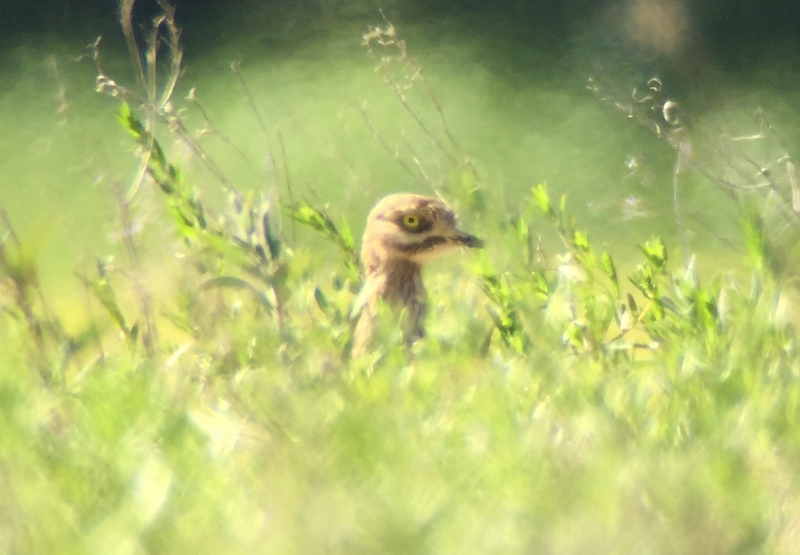 Stone Curlew – one of a pair in a field this morning
Stone Curlew – one of a pair in a field this morning
The Stone Curlews were very hard to see at times in the vegetation, particularly when they sat down. However, with patience we were treated to great views through the scope as they walked around in the field. Even when they sat down, we could still see their heads – the striking yellow iris and black-tipped yellow bill.
A couple of Brown Hares were in the field too. At first, they sat opposite each other, facing off. But then we were treated to a quick boxing bout, as one ran towards the other and they both reared up and flapped their front legs at each other. Then they gave up and went back to feeding quietly.
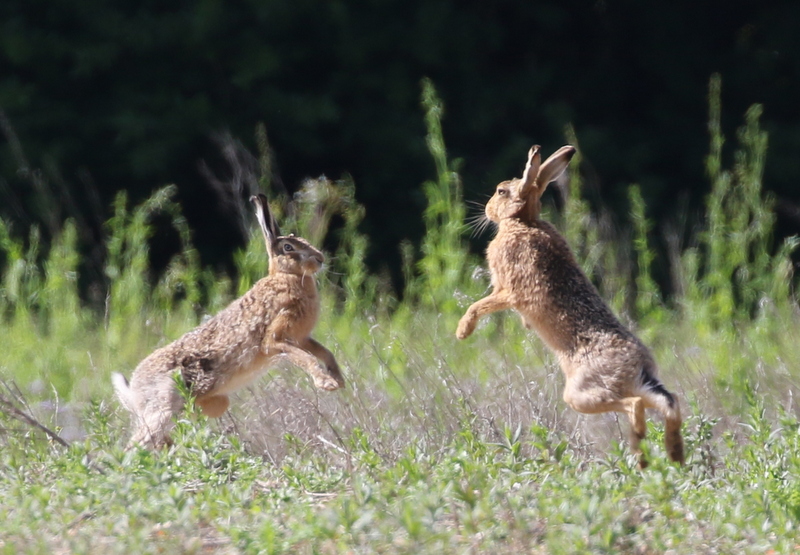 Brown Hares – this pair treated us to a quick bout of boxing
Brown Hares – this pair treated us to a quick bout of boxing
With great views of Stone Curlew in the bag, we moved quickly on. Lakenheath Fen was to be our main destination for the morning. It is a big reserve and we wanted to allow some time to explore as much of it as possible. We did stop at another couple of sites on our way, but couldn’t find any more Stone Curlews at either of these places today – they were obviously hiding in the vegetation here, perhaps not a surprise for a mostly crepuscular species, and with the day warming up nicely.
We did find a few Red-legged Partridges in the fields on our stops. A family of Mistle Thrushes were feeding down in the grass, a Jay flew across and landed on a fence post and a Marsh Tit calling from a line of trees were all nice additions to the day’s list.
After a rather leisurely journey down, it was already quite late in the morning by the time we got to Lakenheath Fen, so we set out straight away onto the reserve. There were lots of butterflies feeding on the brambles by the path in the sunshine – Red Admirals, Small Tortoiseshells and a Peacock. A single Common Blue was in the grass too as we walked past.
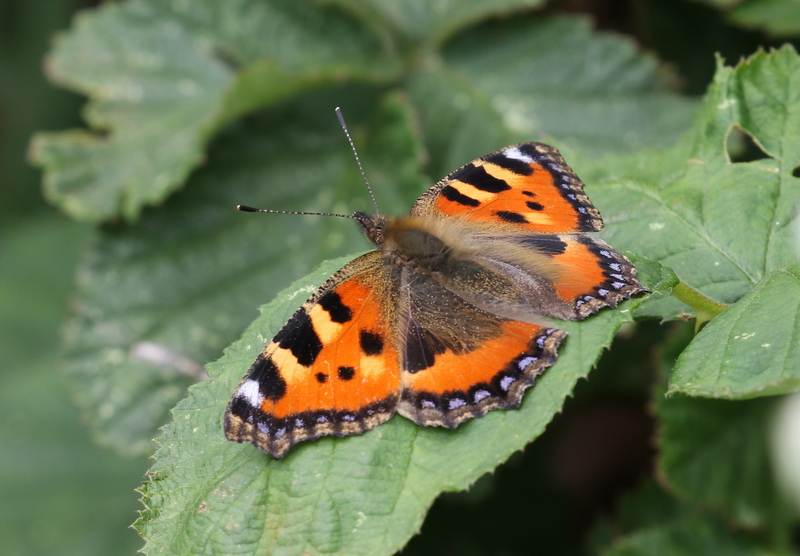 Small Tortoiseshell – several butterflies were feeding on the brambles on the walk out
Small Tortoiseshell – several butterflies were feeding on the brambles on the walk out
There were a few warblers singing as we walked out. A Common Whitethroat was lurking in the bushes, we could hear Reed Warblers in the reeds, a Cetti’s Warbler shouted at us as we passed. Both Blackcap and Garden Warbler were singing from deep in the poplars but they were impossible to see amongst all the fluttering leaves.
There was quite a crowd gathered at New Fen viewpoint as we arrived. There had been a report of a possible Little Bittern heard here yesterday, but we didn’t hear anything other than the nattering of all the people. A Great Crested Grebe was out on the water in front of the viewpoint, along with its stripy-headed chick. A Grey Wagtail was more of a surprise here, flying overhead before dropping down into the reeds. We could hear a male Cuckoo singing from the poplars and someone pointed out a female Cuckoo lurking in the top of one of the bushes out in the reeds.
 Cuckoo – a female, with rusty brown around the upper breast and neck
Cuckoo – a female, with rusty brown around the upper breast and neck
We got a good look at the female Cuckoo through the scope, noting the rusty brown tones to the upper breast, rather than the clean grey hood of the male. We heard lots of Cuckoos here today – both singing males with the classic ‘cook-coo’, the strange bubbling call of the females, and excited males giving various more elaborate song variations in response. It is such a scarce bird in the wider countryside these days, it is always great to come to a reserve like Lakenheath Fen where they are still relatively common and listen to them.
After a short rest at New Fen, we carried on up the main path. A Kingfisher zipped across out of the poplars and over the bank to New Fen, but too quickly for everyone to get onto it. A smart male Marsh Harrier, with silvery grey wings and black tips, circled up out of the reeds and over West Wood. A single Hobby, our first of the day, flew low across New Fen, just visible over the vegetation on the bank.
There were lots of damselflies in the vegetation by the path, mostly Azure Damselflies and Blue-tailed Damselflies, but along the path on the edge of West Wood we found quite a few Red-eyed Damselflies in the reeds and nettles too. We had hoped to find a Scarce Chaser along here, but it was rather breezy along here now and there were just a few Four-spotted Chasers.
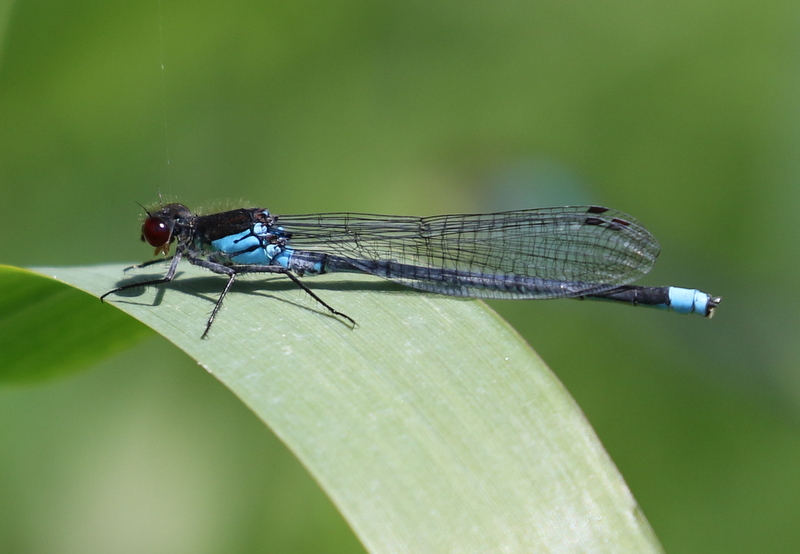 Red-eyed Damselfly – several were along the path by West Wood
Red-eyed Damselfly – several were along the path by West Wood
With one eye on the clock to make sure we got back in time for lunch, we made our way quickly out to Joist Fen viewpoint. We had been told on the walk out that the Bitterns had been showing very well here this morning, flying back and forth, but it seemed rather quiet at first, when we got there. We couldn’t hear any booming – it was the middle of the day by now, which can be a quieter time. There were at least six Hobbys hawking for insects distantly out over the reeds and several Marsh Harriers circling up. All the group finally got to see a Kingfisher here, with a couple zipping in and out out over the reeds carrying food.
Thankfully we didn’t have too long to wait. Suddenly a Bittern flew up out of the reeds. It turned and flew straight towards us, giving us a great look at it as it flew round and out of sight behind the bushes beyond the shelter. That would have been nice enough, but it then came over the bushes and turned back towards us, flying round close past behind us, croaking as it went. Wow!
 Bittern – great views as it flew round the Joist Fen viewpoint
Bittern – great views as it flew round the Joist Fen viewpoint
The Bittern flew about 180 degrees round the viewpoint, before finally bearing away to our left and dropping down into the reeds beyond, giving us all stunning flight views. A minute or so later, what was presumably the same bird started booming over in that direction. We couldn’t have asked for a better show.
With such great views of Bittern already, we decided that wouldn’t be bettered and started making our way back for lunch. As we walked back along the main track, a couple of Hobbys appeared over West Wood. They were joined by more and soon we had five Hobbys hanging in the air or circling. Even better, a couple of them drifted out over the reeds towards us, giving us our best views of the day overhead.
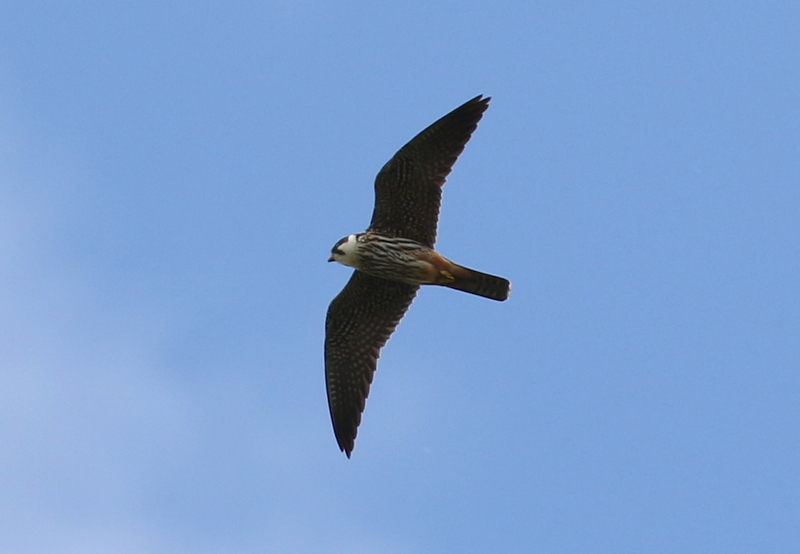 Hobby – great views overhead on the walk back
Hobby – great views overhead on the walk back
Our luck was in with the dragonflies on the way back too. A young male Scarce Chaser flew past, a flash of rich orange, and landed on a reed stem nearby. We had seen a couple of Hairy Dragonflies on the walk out, but a smart male stopped nicely for us in the sun now. We also managed to find a Variable Damselfly with all the Azure Damselflies too.
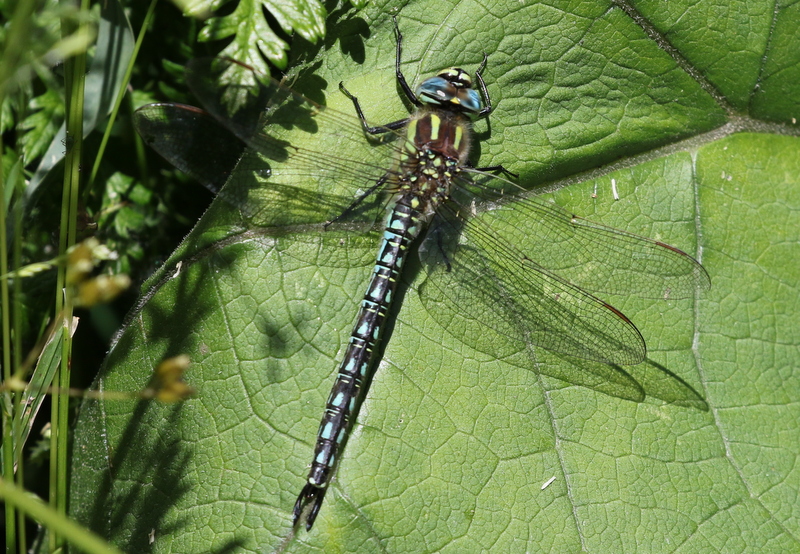 Hairy Dragonfly – a male, with distinctive hairy thorax
Hairy Dragonfly – a male, with distinctive hairy thorax
After lunch back at the Visitor Centre, we headed off into the Forest to try to find some other of our target birds for the day. There has been a Wood Warbler singing near Brandon for about ten days now and it has been showing very well at times. We drove down the track and parked, before walking along the path to where it has been seen. Even before we got there, we could hear it singing.
As we walked in to the trees, it was clear the Wood Warbler was singing from low down and right by the path. We were treated to some great views as it fluttered around only a couple of metres up in some small trees just a short distance ahead of us, even coming right towards us along the path at one point. We even managed to get it in the scope briefly, when it perched still for a while, singing. Bill open, its whole body quivered with the effort of delivering its song, sounding rather like a spinning coin slowly settling on a hard surface.
 Wood Warbler – showed very well, singing right in front of us
Wood Warbler – showed very well, singing right in front of us
Wood Warbler is a very scarce bird here these days, though it is still found in the wetter woods of the north and west of the country. It used to be a regular breeder here albeit in small numbers, but has now all but disappeared, with just the occasional lone bird found singing, possibly a northbound migrant which has stopped off for some reason to try its luck. This has been a better spring for them, with several seen this year, but still it is unlikely any will manage to pair up and breed. Eventually, the Wood Warbler started to move higher into the trees, so after seeing it so well we moved quickly on.
Our luck was in now, as we headed over to another site in the Forest and immediately heard a Redstart singing from a small group of trees as soon as we arrived. We made our way round to the other side, at a discrete distance so as not to disturb it, and the Redstart suddenly appeared in the top of a large hawthorn. Through the scope, we got a great look at it, bright reddish-orange below, black faced and with its striking white forehead shining in the sun. Male Redstarts are really stunning birds to see.
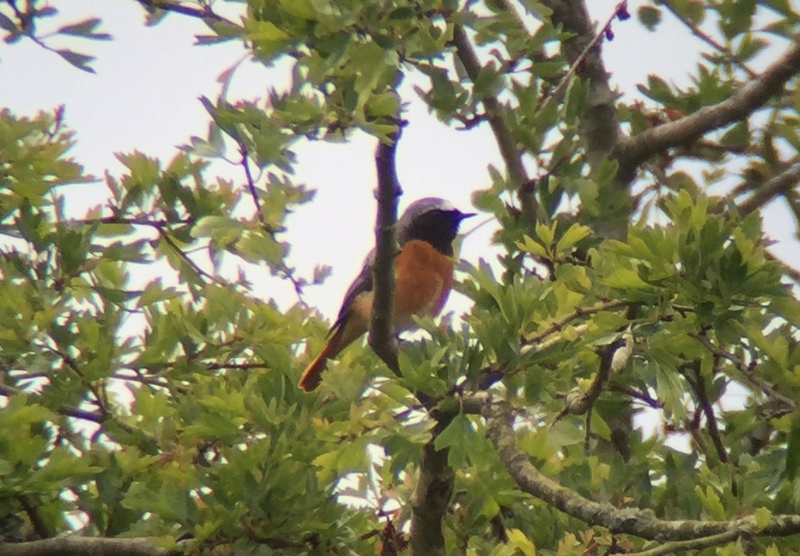 Redstart – a cracking male singing on the edge of the Forest
Redstart – a cracking male singing on the edge of the Forest
The Redstart kept dropping down out of sight, but then coming back up into the top of the hawthorn to sing. The song is easily overlooked, a series of short, melodic but slightly sad sounding bursts interspersed with long pauses. We stood and listened to it for a while, until it worked its way through the bushes and round to the other side of the trees, out of view.
Like the Wood Warbler, Redstarts used to be much commoner birds in this part of the country, but declined through the last century and are now mostly confined to a few sites around the Forest. So it is always a treat to see one here and particular to hear it singing.
Our final destination for the afternoon saw us park up by a forestry track and walk deeper into the forest. It was rather quiet in the trees, with just the odd Goldcrest or Coal Tit heard in the dense coniferous plantations. We made our way round to a clearing and, as we approached, a pair of Stonechats were perched in the top of an old stump row, calling. They were collecting food, so presumably had young nearby. A couple of Whitethroats appeared with them.
We had come looking for Tree Pipit and a short snatch of half song suggested there might be one close by. We walked round to the other side of some trees and there it was, perched in some dead branches. It stayed there for a few seconds, pumping its tail, and we could see it was colour-ringed, before it flew up into a tall birch tree nearby. Almost immediately it dropped back down towards the clearing and was followed by a second Tree Pipit, presumably a pair.
 Tree Pipit – appeared in some dead branches in front of us
Tree Pipit – appeared in some dead branches in front of us
One of the two Tree Pipits dropped down to the ground out of sight, but the second, presumably the male and the same bird we had seen first, landed in the top of a young fir tree, where we could get it in the scope. We had a great look at it, as it stayed there for ages, preening for a while, looking round, turning so we could see it front on as well.
While we were standing here watching the first Tree Pipit, we just caught what sounded like the song of another way off in the distance. Scanning the young trees, we managed to find it, perched in the top of another small fir, right over the other side of the clearing. It is great to think there might be two pairs here this year.
Eventually, the first Tree Pipit dropped down to the ground out of view, so we left them to feed quietly. It was time to call it a day anyway now, so we made our way back to the car. It had been a very successful day in the Brecks, and a great way to round off an exciting three days of summer birding in East Anglia.
















